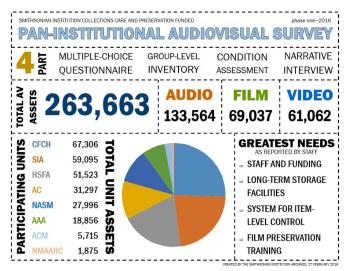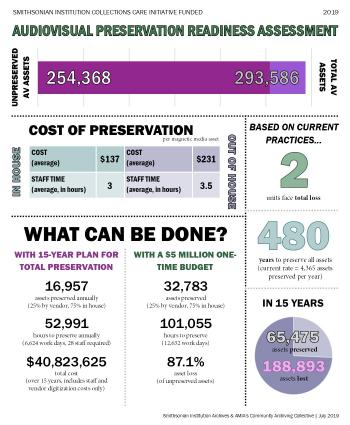Pan-Institutional Survey
 The Smithsonian Institution Archives, partnering with seven Smithsonian units, conducted a comprehensive survey of audiovisual collections consisting of analog film, audio, and video held across the Institution. Proposed by the Audiovisual Archivists Interest Lunch (AVAIL) group and funded by the Collections Care and Preservation Fund (CCPF), this project will provide a foundation for the Smithsonian to develop pan-institutional guidelines on the preservation and care of these materials. The primary goals of this survey are to first document the breadth and scope of audiovisual collections by gathering group-level data on formats, condition, and storage environments, and to secondly report on areas of greatest strengths and needs in preservation practices gleaned from staff interviews.
The Smithsonian Institution Archives, partnering with seven Smithsonian units, conducted a comprehensive survey of audiovisual collections consisting of analog film, audio, and video held across the Institution. Proposed by the Audiovisual Archivists Interest Lunch (AVAIL) group and funded by the Collections Care and Preservation Fund (CCPF), this project will provide a foundation for the Smithsonian to develop pan-institutional guidelines on the preservation and care of these materials. The primary goals of this survey are to first document the breadth and scope of audiovisual collections by gathering group-level data on formats, condition, and storage environments, and to secondly report on areas of greatest strengths and needs in preservation practices gleaned from staff interviews.
Unit Participants
- Anacostia Community Museum (ACM)
- Archives of American Art (AAA)
- Center for Folklife and Cultural Heritage’s Ralph Rinzler Folklife Archives and Collections (CFCH)
- Human Studies Film Archives (HSFA)
- National Air and Space Museum Archives (NASM)
- National Museum of African American History and Culture (NMAAHC)
- National Museum of American History Archives Center (AC)
- Smithsonian Institution Archives (SIA)
Audiovisual Preservation Readiness Assessment
 From December 2017 to May 2019, eleven Smithsonian units participated in an Audiovisual Preservation Readiness Assessment (AVPRA), building off of the 2016 Pan-Institutional Audiovisual Collections Survey. The purpose of AVPRA was to 1) complete and update the 2016 inventory of analog audiovisual holdings at the Smithsonian Institution; 2) develop and implement a method to prioritize analog audiovisual collections for preservation; 3) evaluate the Institution’s current audiovisual preservation practices; and 4) determine the risk for permanent collection loss at current preservation rates and establish preservation scenarios which can mitigate that loss.
From December 2017 to May 2019, eleven Smithsonian units participated in an Audiovisual Preservation Readiness Assessment (AVPRA), building off of the 2016 Pan-Institutional Audiovisual Collections Survey. The purpose of AVPRA was to 1) complete and update the 2016 inventory of analog audiovisual holdings at the Smithsonian Institution; 2) develop and implement a method to prioritize analog audiovisual collections for preservation; 3) evaluate the Institution’s current audiovisual preservation practices; and 4) determine the risk for permanent collection loss at current preservation rates and establish preservation scenarios which can mitigate that loss.
The Smithsonian Institution Archives served as the lead unit for the project under the direction of Alison Reppert Gerber, Preservation Coordinator, and Kira Sobers, Digital Media Coordinator. As the Community Archiving Collective (CAC) under the Association of Moving Image Archivists (AMIA), contracted audiovisual archivists Kelli Hix, Marie Lascu, and Moriah Ulinskas conducted the assessment and prepared the report. Funding for the project was provided by the National Collections Program’s Collections Care Initiative (CCI).
Unit Participants
- Archives of American Art (AAA)
- Anacostia Community Museum (ACM)
- Center for Folklife and Cultural Heritage’s Ralph Rinzler Folklife Archives and Collections (CFCH)
- National Anthropological Archives | Human Studies Film Archives (NAA-HSFA)
- National Air and Space Museum Archives (NASM)
- National Museum of African American History and Culture (NMAAHC)
- National Museum of American History Archives Center (NMAH-AC)
- National Museum of the American Indian (NMAI)
- National Portrait Gallery (NPG)
- Smithsonian American Art Museum (SAAM)
- Smithsonian Institution Archives (SIA)
